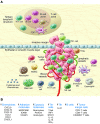From mice to humans: developments in cancer immunoediting
- PMID: 26241053
- PMCID: PMC4588291
- DOI: 10.1172/JCI80004
From mice to humans: developments in cancer immunoediting
Abstract
Cancer immunoediting explains the dual role by which the immune system can both suppress and/or promote tumor growth. Although cancer immunoediting was first demonstrated using mouse models of cancer, strong evidence that it occurs in human cancers is now accumulating. In particular, the importance of CD8+ T cells in cancer immunoediting has been shown, and more broadly in those tumors with an adaptive immune resistance phenotype. This Review describes the characteristics of the adaptive immune resistance tumor microenvironment and discusses data obtained in mouse and human settings. The role of other immune cells and factors influencing the effector function of tumor-specific CD8+ T cells is covered. We also discuss the temporal occurrence of cancer immunoediting in metastases and whether it differs from immunoediting in the primary tumor of origin.
Figures


Similar articles
-
Longitudinal Immune Profiling Reveals Unique Myeloid and T-cell Phenotypes Associated with Spontaneous Immunoediting in a Prostate Tumor Model.Cancer Immunol Res. 2021 May;9(5):529-541. doi: 10.1158/2326-6066.CIR-20-0637. Epub 2021 Feb 26. Cancer Immunol Res. 2021. PMID: 33637604 Free PMC article.
-
Sculpting tumor microenvironment with immune system: from immunometabolism to immunoediting.Clin Exp Immunol. 2019 Aug;197(2):153-160. doi: 10.1111/cei.13293. Epub 2019 Apr 1. Clin Exp Immunol. 2019. PMID: 30873592 Free PMC article. Review.
-
Targeting tumors with IL-21 reshapes the tumor microenvironment by proliferating PD-1intTim-3-CD8+ T cells.JCI Insight. 2020 Apr 9;5(7):e132000. doi: 10.1172/jci.insight.132000. JCI Insight. 2020. PMID: 32271164 Free PMC article.
-
A Threshold Level of Intratumor CD8+ T-cell PD1 Expression Dictates Therapeutic Response to Anti-PD1.Cancer Res. 2015 Sep 15;75(18):3800-11. doi: 10.1158/0008-5472.CAN-15-1082. Epub 2015 Jul 24. Cancer Res. 2015. PMID: 26208901
-
Metabolism and Gut Microbiota in Cancer Immunoediting, CD8/Treg Ratios, Immune Cell Homeostasis, and Cancer (Immuno)Therapy: Concise Review.Stem Cells. 2019 Oct;37(10):1273-1280. doi: 10.1002/stem.3051. Epub 2019 Jul 17. Stem Cells. 2019. PMID: 31260163 Review.
Cited by
-
Mitigating non-genetic resistance to checkpoint inhibition based on multiple states of immune exhaustion.NPJ Syst Biol Appl. 2024 Feb 9;10(1):14. doi: 10.1038/s41540-024-00336-6. NPJ Syst Biol Appl. 2024. PMID: 38336968 Free PMC article.
-
Immunotherapy in the Treatment of Metastatic Melanoma: Current Knowledge and Future Directions.J Immunol Res. 2020 Jun 28;2020:9235638. doi: 10.1155/2020/9235638. eCollection 2020. J Immunol Res. 2020. PMID: 32671117 Free PMC article. Review.
-
Immune Landscape in Tumor Microenvironment: Implications for Biomarker Development and Immunotherapy.Int J Mol Sci. 2020 Aug 1;21(15):5521. doi: 10.3390/ijms21155521. Int J Mol Sci. 2020. PMID: 32752264 Free PMC article. Review.
-
Immunoediting Dynamics in Glioblastoma: Implications for Immunotherapy Approaches.Cancer Control. 2024 Jan-Dec;31:10732748241290067. doi: 10.1177/10732748241290067. Cancer Control. 2024. PMID: 39353594 Free PMC article. Review.
-
Ferroptosis-related genes identify tumor immune microenvironment characterization for the prediction of prognosis in cervical cancer.Ann Transl Med. 2022 Jan;10(2):123. doi: 10.21037/atm-21-6265. Ann Transl Med. 2022. PMID: 35282071 Free PMC article.
References
Publication types
MeSH terms
LinkOut - more resources
Full Text Sources
Other Literature Sources
Research Materials

